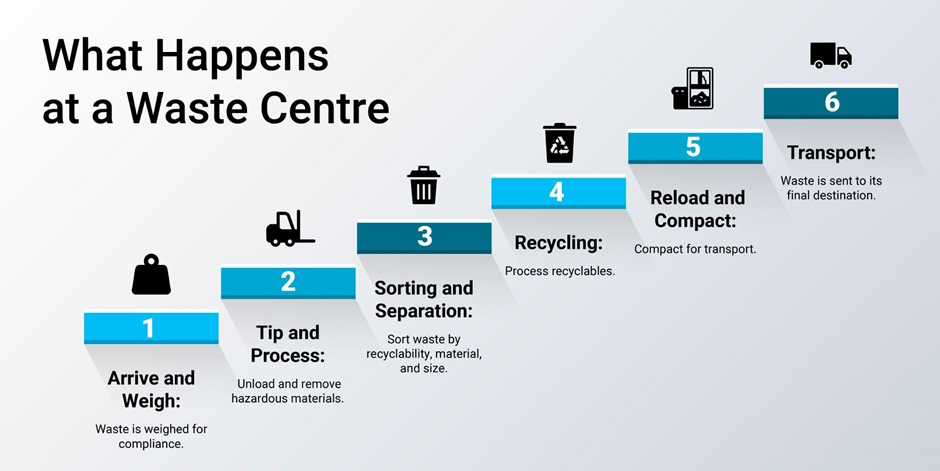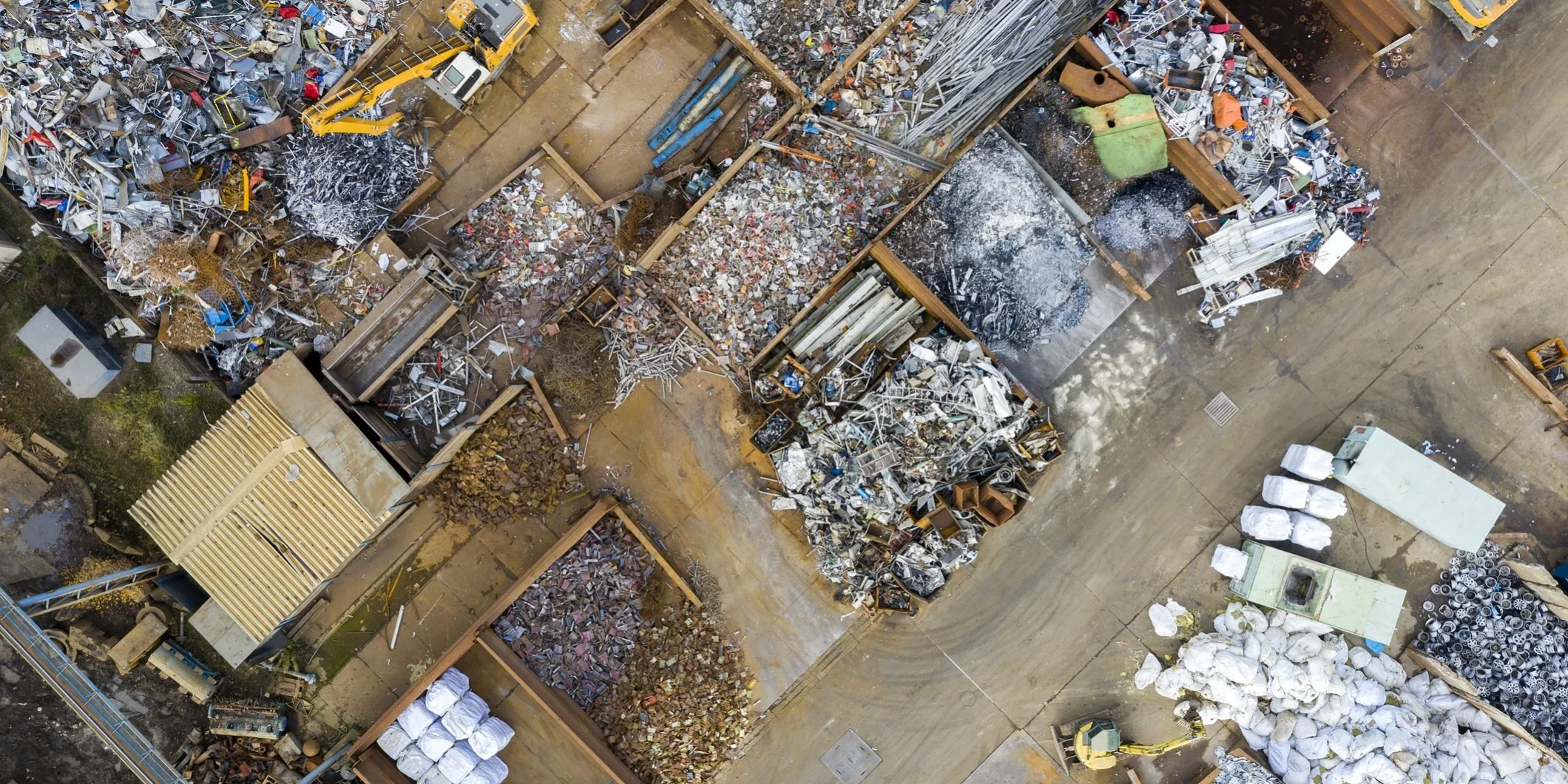When you book skip hire or a waste pick-up, you might wonder where your waste goes and how it’s handled. Many people don’t realise that waste management involves a detailed and structured process to ensure that everything is dealt with properly. At Batesy Skip Hire, for instance, we take waste to our dedicated waste centre, where it is sorted, processed, and disposed of in the most environmentally responsible way.
In this article, we’ll explain in detail how waste is managed and disposed of at waste centres, giving you a clear understanding of the processes involved.
What is a Waste Transfer Station?
A waste transfer station, often referred to simply as a waste centre, is a centralised facility where waste collection vehicles unload their waste. At this point, the waste is sorted, screened, and prepared for further transportation to its final destination, whether that’s a waste recycling centre, a landfill, or a waste-to-energy facility.
Waste transfer stations are integral to sustainable waste management. They ensure that waste is separated into different streams (e.g. recyclables, green waste, non-recyclables) before being sent to waste recycling centres or other disposal sites. By consolidating waste at a central location, waste transfer stations can streamline the transportation process, reducing the number of trips required and making the disposal process more efficient.
In simple terms, a waste transfer station acts as the first line of defence in the waste disposal process, helping to divert as much waste from landfill as possible.
Waste Transfer Station vs Material Recovery Facility (MRF)
Although the terms waste transfer station and material recovery facility (MRF) are sometimes used interchangeably, there are key differences between the two.
Waste Transfer Stations primarily focus on consolidating waste for more efficient transport. They don’t typically separate or process waste in great detail; their main function is to organise and prepare waste for further disposal, whether to a recycling centre or landfill.
Material Recovery Facilities (MRFs), on the other hand, take the process a step further. They are specifically designed to separate recyclable materials from non-recyclables. Through advanced sorting technologies and manual processes, materials like paper, metals, plastics, and glass are extracted and prepared for recycling.
While many waste transfer stations include some level of material recovery, they typically don’t process the waste as thoroughly as MRFs. However, the lines are often blurred, and some waste centres are equipped with MRF capabilities.
The Waste Management Process at a Waste Centre
So, what happens to your waste once it’s delivered to a waste transfer station? The process is more structured than many might realise, and it involves multiple stages to ensure that waste is handled correctly and responsibly.

1. Arrive and Weigh
The first step in the waste management process is weighing the waste. This is not only important for logistical purposes but is also a requirement under waste management regulations. The weight of the waste is recorded, typically on Waste Transfer Notes (WTNs), which serve as proof that the waste has been transferred to a licensed facility. This step is essential for tracking waste, ensuring compliance with regulations, and maintaining transparency throughout the waste disposal process.
2. Tip and Process
Once the waste is weighed, it’s unloaded from the collection vehicle at the waste centre. The waste is then screened for hazardous waste such as chemicals, asbestos, or medical waste, which must be treated separately from regular waste to prevent harm to the environment and human health. Any unsuitable materials are removed and disposed of in compliance with safety protocols.
3. Sorting and Separation
After the hazardous materials have been removed, the waste moves on to the separation process. During this stage, the waste is sorted based on various characteristics. First, recyclability is taken into account, with materials such as paper, wood, and metal being separated from non-recyclable items like food waste or broken furniture. Next, the waste is categorised by material type, with distinct piles or containers created for paper, plastics, metals, and glass. Finally, the waste is sorted by size, with large and bulky items being separated from smaller ones to make processing more efficient. This step ensures that all waste is appropriately categorised for further handling or recycling.
4. Recycling
Some waste centres, like ours at Batesy Skip Hire have integrated waste recycling centres, meaning that recyclable materials like wood and metal can be processed directly at the waste centre itself. This not only reduces the need for raw materials but also conserves energy and reduces carbon emissions surrounding production and transportation. Waste centres that do not have recycling capabilities will instead transfer their recyclable waste to a recycling facility, where it can be processed and turned into new products.
5. Reload and Compact
Once waste is sorted, compactors and balers are used to compress non-recyclable materials. Compacting the waste makes it easier to transport and helps save space, meaning that more waste can be transported with fewer trips, saving on fuel and reducing carbon emissions. The waste is then reloaded into larger vehicles for transportation to the next stage.
6. Transport to Final Destination
The final step in the waste management process is the transportation of the sorted and compacted waste to its ultimate destination. Non-recyclable materials that cannot be processed or reused are typically sent to a landfill, where they are safely contained. In some cases, waste that cannot be recycled but still holds energy potential is sent to waste-to-energy plants, where it is converted into energy, helping to reduce the need for fossil fuels.
Waste Management at Batesy Skip Hire: Our Waste Transfer and Recycling Centre
At Batesy Skip Hire Ltd, we understand the growing environmental challenges posed by traditional landfill sites. That’s why we have invested in a state-of-the-art waste transfer station and recycling centre in Belfast. Our goal is simple: to divert as much waste as possible from landfills and ensure responsible, eco-friendly waste removal for both homes and businesses.
We’re proud to recycle up to 95% of the waste we receive. This significantly reduces the environmental impact of both commercial and domestic waste removal and contributes to a circular economy.
We accept a wide range of waste, including:
- General waste: Non-recyclable waste from homes and businesses.
- Timber: Wood waste that can be recycled or repurposed.
- Plastics: Various plastics, including containers, packaging, and more.
- Cardboard: Recyclable cardboard that can be turned into new products.
- Masonry: Construction and demolition waste, including concrete and bricks.
- Green waste: Garden waste such as grass, leaves, and branches.
- Metals: Ferrous and non-ferrous metals, which can be recycled into new metal products.
If you are in need of a responsible garbage disposal service that reduces landfill usage, conserves natural resources, and lowers greenhouse gas emissions, Batesy Skip Hire has got you covered. Contact us to arrange a waste removal today!







